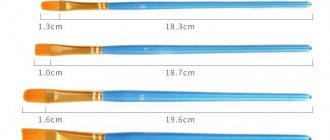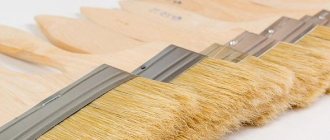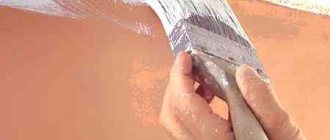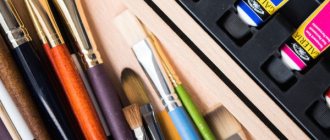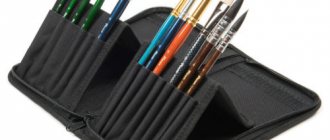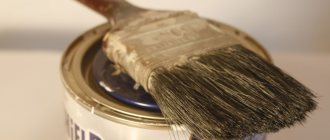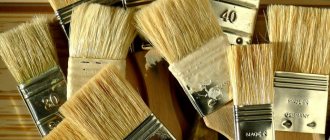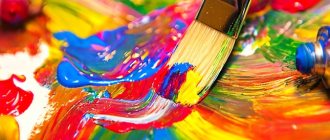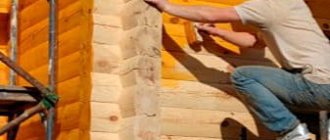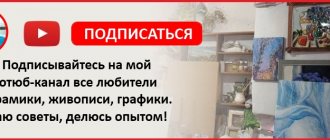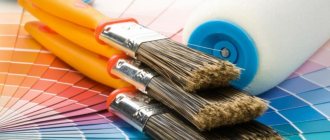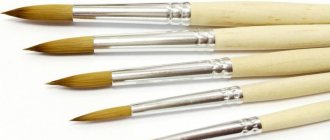6 brushes, different bristles. Review of brushes with different bristles, as well as palettes for painting. Which brush is better: squirrel, goat, kolinsky, pony, bristles or synthetic?
Which brushes are ideal depends on the quality of the brushes, paints (watercolor, oil, gouache, etc.), and the habits of the painter.
Squirrel brushes are the softest and most flexible. Colonel is soft, but elastic, it is tougher than squirrel. Modern synthetics are close in quality to columnar. It does not wear out as quickly as natural bristle brushes, and is even more convenient to use because its bristles are smoother. Most artists prefer to work with natural brushes, but synthetic brushes are also great for children’s painting.
To paint with watercolors, use brushes: squirrel, kolinsky, synthetic.
Kolinok is suitable for any style of painting, but it is also one of the most expensive. If you are in doubt about which brush to choose, you can use Kolinsky.
Squirrel
good for watercolors, synthetics - for acrylic painting. The tip of the squirrel hair brush is sharp and has the same fluidity control as a kolinsky brush, but is not as elastic as a kolinsky brush.
- Catalog of painting brushes - choose!
Pony
Usually they take it when it is not possible to take a weasel or a squirrel. Ponies are tougher than squirrels, they are closer to the column.
Pig bristle brush
Best suited for acrylic and oil, it allows you to work even with very thick paint.
Badger brush
good for soft paints, it is very easy to work with.
Sable
In terms of properties, it combines the kolinsky and the squirrel; number 2 can be used to paint both miniatures and large works.
Nylon bristles (synthetic)
Not suitable for watercolor, but great for acrylic.
The brush should not be very soft, but not too hard.
Squirrel brushes
The traditional, well-known brush is a squirrel brush, it is soft, thin and elastic, the strokes are juicy and bright. It usually consists of a wooden stylus and a galvanized braid that clamps the squirrel's hair. Brushes with different bristles.
The squirrel brush holds its shape perfectly, does not break, absorbs moisture well and is easy to clean under running water. When in contact with paper and other surfaces (porcelain, earthenware, wood), the hairs do not separate and lead a clear line, without “stripes”.
The most valuable among artists are brushes made from the upper part of the tail of a Siberian squirrel. The best hair is in the tail
whites, the hairs are the longest there.
Squirrel fur has good moisture retention properties, which makes it different from kolinka hair when working with watercolors and tempera paints. When wet, a squirrel brush gathers into one dense bunch, which is suitable for painstaking contour work. It can be kept in water for a long time.
Squirrel brushes are mostly round, but squirrel brushes can also be used to make brushes of other shapes.
So: squirrel brushes are used mainly for working with watercolors and water-based paints
. Squirrel brushes are not suitable for oil paints; they are very delicate and immediately begin to peel off from the solvent.
Squirrel brushes need to be looked after, washed after use, dried, and put in a box.
Tips for beginning artists
Do you want to paint real gouache paintings? You should start by purchasing the necessary materials. For beginners, you will need paper, a box of paints, brushes, a palette for mixing tones, water containers, and a simple pencil. The minimum set contains 12 basic paints; when combined, a wide variety of colors and shades are obtained. More experienced craftsmen also have other tools and devices - for example, a palette knife - a device for mixing and removing remnants of gouache, applying thick paint to canvas.
At the beginning of work, it is recommended to draw the lightest images in gouache - mountains, trees, landscapes. You should only move on to still lifes or portraits if you have certain skills, after attending painting and fine art classes. Sketches should be carefully drawn in pencil, this will help avoid mistakes on paper.
Column Brushes
The kolonok is an animal from the weasel family, its fur has excellent properties - it is soft and elastic. The bristles of the kolinsky brush adhere perfectly to water, improve the flow of paint, and are suitable for working with watercolors (including professional ones).
The core brush is the leader among brushes. The hair of kolinsky brushes is thin, elastic and has a conical shape. The paint flows from the tip of the brush in a continuous stream and with the best consistency. They are distinguished by a combination of elasticity and elasticity, at the same time they remain soft. From top to bottom, in the photo brushes: nylon 7, goat 7, synthetic 6, synthetic 5, kolinsky 4, squirrel 7.
Column brushes are designed for artistic work with watercolor, oil, tempera, gouache and acrylic.
. In oil painting they are used for small details. There are round and flat.
But who is this speaker? Few have heard of this animal.
The kolinok (lat. Mustela sibirica) is a valuable fur-bearing commercial animal, from the genus of weasels and trochees, its fur is highly valued, and long hairs from the tail are used for artists’ brushes. The fur of the kolinok is very thick, soft, warm, and lush.
Kolonok is a red animal, smaller in size than a cat, flexible, and has a black “mask” on its face. He hunts relatively large animals: hares, black grouse, wood grouse. It does not consume plant foods; in extreme cases, it can feed on insects. All winter he sits in a hole, moving, if necessary, under the snow. In the snow tunnels, the kolonok catches voles. He stores food for the winter and sets up entire warehouses.
Winsor & Newton Series 7 brushes (see brush catalogue) are the highest quality kolanka brushes available. The name of the series comes from 1866, when Her Majesty Queen Victoria ordered W&N to produce brushes for her of the best quality, her favorite size No. 7. As a result, Winsor&Newton named a whole series of brushes “Series7” in honor of this memorable event. These brushes are handmade
.
They will give you a unique pleasure from working with watercolors, because they are made by professionals from the best materials and according to the best traditions, by hand. True, their price is... very high, like a king
.
Brushes “Series 7” from Winsor&Newton, columns.
How to choose art brushes
There is nothing difficult in choosing a drawing tool, since the quality is immediately visible. But, in order for your purchase to be a pleasure to work with, you should pay attention to some nuances.
1. It doesn’t matter whether painting brushes are sold in Korolev or Moscow, they need to be checked before purchasing. The first thing you need to pay attention to is the bun. If the protective cap is removed from it, then it is quite possible that its fibers are broken, which, instead of beautiful, even lines, can give a completely unexpected effect when drawing. The picture will be in the style of abstractionism.
2. Don't think that new brushes for painting in Korolev are any different from products for professional artists in other cities. They behave the same capriciously everywhere: you won’t be able to draw well with them right away; they need to be “soaked” so that a bunch-like shape appears.
3. How can you tell if an overly friendly seller is offering you good art brushes? Tap such a wet brush, or rather its handle, on your hand. Good art brushes have sharp tips right away.
4. Well, now it’s time to try the tool in action. But, get ready for the fact that when buying brushes for painting, in some stores you may encounter the ignorance of the seller, who will look with surprise at all your operations with a tool that has not yet been purchased. We are well aware of the peculiarities of choosing brushes, so we will provide you with the opportunity to test any brush.
5. Bend the end of the bundle: it should take the same shape.
6. If you choose artistic brushes for watercolors, then ask yourself a glass of water, paint and draw a portrait of a seller who is dissatisfied with such a demanding buyer. If the tool has a thin tip, good elasticity and resilience, as well as the ability to retain moisture, then both of you will be satisfied.
If the tool has a thin tip, good elasticity and resilience, as well as the ability to retain moisture, then both of you will be satisfied.
7. If you see that the clip does not fit tightly to the handle, or, even worse, can turn around its axis, then this is clearly a low-quality tool. Painting brushes like this simply shouldn't be sold.
Pony brushes
Unlike ordinary horses, which have hard hair, pony hair (from the mane and tail) is soft, so it is used to make tassels. Scottish pony hair is especially valued for brushes. The pony brush hair is of medium hardness, closer to soft.
The hairs of a pony's brushes are somewhat thicker than those of a squirrel, the distance between the hairs is greater, so such a brush takes up less water than a squirrel or column brush. Gathers into a cone shape, not too elastic.
Ideal for beginning artists and often used in children's educational institutions.
Advantages: reliability, durability (strong, thick hair).
Used mainly for paints: watercolor, gouache, tempera, as well as glue and cosmetic purposes
.
Often used by preschool and primary school children.
Pony brushes absorb paint well, but they don’t give off paint as readily as they absorb it.
How to distinguish a good brush from a fake
Professional art brushes should form a sharp tip when in contact with water, demonstrate excellent elasticity of the hair tuft, and prevent paint from spreading. Brushes, like any instrument, need good care. If you have to work with them for a long time, then they can be left in a bowl with kerosene for several days. Before you start working with them again, you need to wipe the hair bun with a clean rag made from natural materials (cotton, chintz).
If you do not plan to use your brushes soon, you should wash them in soapy suds (use high-quality soap!) and then rinse them with clean water. For long-term storage, art brushes should be dipped in linseed oil, but make sure that they do not reach the bottom (so as not to spoil the shape of the bunch).
Bristle brushes
Bristle brushes are made from selected pig ear hair. Bristle brushes are used for professional watercolor painting on paper with a rough texture, on canvas.
Bristle brushes are especially convenient for drawing contours and creating contrasts; the hairs should not bristle.
The best bristle brushes are made from the hair of the Chinese Angking hog. The elastic, strong bristles of this animal (hair reaches 20 cm) are subjected to special processing - the bristles are boiled and bleached, and only the white hair is used to make professional brushes.
In addition to elasticity, bristle brushes have another important feature: the split tip of the pig's hair contributes to good fullness of the brush and its even application to the surface. They wear out over time, but are easy to replace because... they are inexpensive.
There are both flat and round, used for working with oil, acrylic paints, and gouache using dry techniques.
.
How to choose brushes for watercolors
But how do you choose, how do you understand which professional artistic brushes are right for you? I offer you some tips for choosing brushes, be sure to read them before purchasing.
Don't buy too many brushes at once
When you first start learning to draw, you already have too much information that you need to remember, keep in mind and constantly apply. You need to understand brushes, but gradually. As I already said, for the first time you will only need 3-4 brushes. And that will be enough, believe me.
Don't overpay for brushes
Any brush will eventually lose its original appearance and you will want to replace it with a new one. This is fine. But it’s very sad and disappointing when you spend a nominal 300-400 rubles on a brush, and after a while you need to change it again.
Beginners should not go to extremes. That is, you don’t need expensive brushes, but don’t choose cheap ones either. Take a few simple natural ones, and the rest from synthetics, which will undoubtedly last longer and cost a little less.
Look at the bristles of the brush when purchasing
In general, I advise you to inspect and “feel” the brush. Are the lint popping out, is the metal border hanging around the lint, and so on? As for the pile, it is desirable that it be long and the tip thinner.
Don't buy all sizes of brushes
The brush numbers for watercolor paints are their sizes. They most often stand at the base of the brushes and start from 00 (the smallest and thinnest brush) to 30 and above. Just like with the shape, choose several different sizes - small, large and medium.
Synthetic brushes
Synthetic brushes are an analogue of natural brush in terms of rigidity and elasticity, and in price - an order of magnitude cheaper. The elasticity of the hair is even higher than that of kolinsky, however, synthetics are inferior to kolinsky in terms of filling the brush with water and the volume of absorbed paint. High quality painting brushes.
With synthetic brushes you can draw clear and even lines.
Synthetic brushes are made from nylon, polyester and other fibers
.
The standard thickness of brush hair is 0.08 mm, but there are other options: with thick hair, the elasticity of synthetic hair is close to bristles, but the shape and water-repellent properties are retained, and with thin hair, a synthetic brush absorbs more water and it becomes softer, close to kolinsky hair .
The quality of synthetic brushes made in Japan is highly valued; they produce fiber using the drawing method; the brush hair is not cut, but pulled at a certain angle. Such brushes are often called artificial kolin, they are resistant to acids and caustic liquids, so they can be used for glue, and they are not afraid of thinners.
Synthetic hair based on nylon
- it is hard and does not release water, it is not suitable for watercolor painting, but
it is excellent for oil paints and acrylic
Synthetic hair based on polyester fibers
has a capillary effect, which allows you to use such brushes even in
watercolors
.
In terms of resistance to mechanical stress, synthetic brushes are inferior to natural ones, because... the fibers quickly wear out and become soft. But such brushes are inexpensive, professional artists buy synthetics in large quantities, and these brushes are very suitable for children’s painting.
Material Reviews
There are a huge variety of brushes now, and the most unusual ones. Once again, going through my brushes, I decided to figure out the types of bristles, what exactly is suitable for what. After all, we draw so often that we no longer think about why a squirrel is used or how a kolinsky differs from a bristle.
Squirrel
One of the most famous brushes with which many begin learning to draw. They are made from hairs from the tail of a squirrel, and the hair taken from the top of the tail is much more valuable. Such brushes are only round, very soft and elastic; they can also be used to make flute-shaped brushes (but the width of the flute is limited). They are mainly used for working with watercolors and water-based paints, because these brushes hold water well. At the same time, the protein is too delicate for oil and may begin to come out from the solvent. Squirrel hair retains its shape perfectly, does not break, absorbs moisture and washes well under running water. The squirrel brush allows you to paint without uneven stripes and blurry spots due to the fact that when in contact with paper, porcelain, earthenware, the hairs do not separate and lead a clear, directional line. Squirrel brushes need to be carefully looked after. The squirrel's hair is very thin, blue, black or brown.
I read here that the material for these brushes can be the bristles of different breeds of Siberian squirrels.
For example, the hair of the CASAN breed is considered the thinnest. It is used to make tools used to paint ceramics and porcelain. The bristles of the TALUTKY breed squirrel are longer and are used for brushes used for calligraphy. CANADISCHE squirrels are valuable for their short, black hair. Each of their hairs has a thin tip. Therefore, this breed of squirrel makes excellent watercolor brushes.
Columns
Brushes made from its bristles are considered very valuable. The kolonok is a cross between a ferret, a marten and a mink at the same time. There are only a few of these animals in nature, and besides, it is not so easy to prepare. For example, the ponytail of a Siberian weasel produces no more than 2 g of bristles, suitable for brushes. It will make 3-4 thin brushes and 1-2 large ones. For brushes, fur is taken only from its tail and only from animals living in the river valleys of Siberia, China and Korea. Kolonkovy hair is very elastic, light and has a sharp tip. The highest quality kolinsky brushes are those made from the bristles of males caught in the winter. By the way, a pile column suitable for painting is called spine. Hair color may vary. It depends on the season in which the animal was caught, generally it is golden brown in color. They are similar in quality to squirrel ones, although there are differences. The villi of the column at the very base are much stiffer and thicker, and at the tip they are softer, very elastic and elastic. The brush can be cylindrical or flat, in different shades from light red to dark brown. These brushes are used for both thin and thick paints. In oil painting they are used when making small details; core brushes are also convenient for glazing techniques on wet surfaces.
Sable
The golden mean between soft squirrel and elastic column. The peculiarity of sable brushes is that they are very durable and almost do not wear out, even when working with rough surfaces; they are made from sable tails. The brush is very flexible, picks up a large volume of paint and releases it in doses. Because of these qualities, such brushes allow you to work in various techniques, from “dry” brushes to wet techniques. Everything can be done with one brush, which is very convenient. The best choice for working with watercolors, egg tempera, gouache. Sable brushes are quite rare and quite expensive, but they are worth it.
Marten
Made from the hair of marten or the weasel family. Brushes made from marten hair differ in their properties, depending on what kind of marten it is: lowland or mountain. Brushes made from plains marten hair are as soft as squirrels, but brushes made from mountain marten hair are a little more elastic. On sale, such brushes are less common than squirrel brushes.
Weasel
An alternative to pile column. The hairs are red-brown in color, with a good sharp tip, good fullness, but not as long as that of the Kolinka.
Bristle
Quite tough, elastic and long. It is sorted by shade (available in black, gray and white) and length, treated with chemicals and bleached. The prepared bristles are doused with boiling water, after which it becomes more elastic. When finished, it has a light color. High quality bristles are produced in China and Russia.
You can distinguish this brush from others by visual inspection - the pig's hair is split at the end. It was this feature that led to the use of pig hair - the specific tip allows the brush to absorb a large volume of paint and apply it evenly, without dipping the brush again. The best brushes of this type have up to 80% split hairs, but for art brushes, calibrated unsplit bristles are still better. These brushes are chosen for painting with oil, acrylic (you don’t need to dilute), gouache and tempera. These brushes have a peculiarity - there is no ending at the beam, thanks to this the brush is able to pick up a fairly large amount of paint and retain it. The basic shape of the brush is flat, although there are cylindrical and fan shapes, as well as fluted ones.
Pony
Soft pile with a cylindrical tuft, absorbs water well. The bristles that grow behind the ears or on the back are used. Brushes are often used in schools and kindergartens to teach watercolor techniques. Brushes made from pony hair absorb paints well, but give them off worse than they absorb, they gather into a cone shape, hold their shape well, but do not have sufficient elasticity. This type of hair, like that of a pony, is classified as a decorative hair type, since it does not have a sharp tip, which is why these brushes are not very suitable for professional work. May be brown or white. Designed for working with water-soluble paint: watercolor, gouache or tempera.
Goat
Goat hair is elastic, resilient and quite long, and comes in white and yellow shades. Softer than pig bristles. The brushes retain their shape, absorb paint and water perfectly, resulting in smooth strokes. They are used in watercolor painting, calligraphy, batik and ceramic painting, and Japanese painting. It is noteworthy that for calligraphy, brushes are used mainly with bamboo handles because of their lightness. This brush is suitable for batik work because it can withstand hot wax.
Ear hair brushes
Such brushes are made from hair that is taken from the inside of the ears of oxen and cows, the quality of which is determined by the breed of the animal. Typically, such brushes are inexpensive, but durable, elastic and sensitive in use, give good results and retain their shape well. The hair has a silky texture. They are made flat and round, and brushes are also made for covering large surfaces. Oxhair brushes are used to work with oil paints, acrylic, tempera, and gouache. Cow hair brushes are used to work with almost all types of paints: watercolor, gouache, tempera, acrylic, oil paints.
Mongoose
Mongoose brushes are easily distinguished by the color of the bristles; the tip is dark brown and the base is black and white or grayish. Brushes are cylindrical or flat, elastic and slightly hard. They are usually used when working with thick paints (for example, oil and acrylic). From my own experience, I can say that it can also be used for painting with watercolors using a dry technique; it holds its shape well and has a thin tip, but does not hold water very well.
Wolf
Rather exotic for us, but quite common in the east. These brushes are made from wolf hair. They are distinguished by their special elasticity and elasticity, thanks to these qualities, such brushes are mainly used for calligraphy and guohua painting (a style of traditional Chinese painting in which ink and water paints are used on silk or paper), brushes made from Chinese yellow wolf, which is essentially a columnar.
Bear
Made from processed brown or polar bear hair. Brushes made from polar bear hair are flat in shape with a long or short hair tuft; brushes made from brown bear hair are round, as in the photo above. These brushes are less rigid, but more elastic compared to bristle brushes; they have high elasticity and softness. Used for “heavy” types of paints: oil paints. gouache, etc. Brushes made from brown bear hair are round in shape and are more soft and elastic. Used for working with tempera, watercolor, ink, etc.
Badger
The hair for these brushes is taken from the tail of a badger. Due to its properties, badger fur has become an ideal material for making butter tools. Brushes made from badger hair are softer than bristle brushes, have a conical shape, and are distinguished by their “fluffiness.” The best badger fur brushes can be identified by their white tip and a stripe in the middle.
Manufacturers sometimes imitate them by dyeing pig bristles or goat hair brushes. However, the latter cannot compare with a badger hair brush in their working properties. If you are not sure about the authenticity of the brush, pay attention to the following: if the hair does not have a “belly” or tip, and there are twisted and curled hairs along its length, then it is a goat hair brush; if there are split hairs, it is hog bristles.
Synthetics
Synthetic brushes are made from nylon, polyester and other fibers. Synthetic hair based on nylon is hard and does not release water, so it is not suitable for watercolor painting, but for oil paints and acrylic this quality is just appropriate. Synthetic hair based on polyesters provides varying degrees of elasticity. Hairs of different lengths and diameters are collected into a bundle, which gives a capillary effect, which allows you to use such brushes even in watercolors.
Such brushes are less prone to destruction under the influence of thinners, insects, paints, and direct sunlight. But due to mechanical stress, these brushes are inferior in wear resistance to natural ones; the bristles quickly wear out and become soft. There are many variations of mixed types of brushes made from different bristles. They mix both natural piles and combine synthetic and natural ones. Recently, the production of synthetic brushes has been actively developing and high-quality synthetics may well replace or complement natural bristles over time.
A short guide to different materials and types of pile.
Oil – brush bristles, kolinsky, ear hair, synthetics, badger. Tempera - synthetics, badger, squirrel, bristle brush, kolinsky, ear hair Gouache - ear hair, synthetics, squirrel, bristle brush, kolinsky Watercolor - squirrel brush, kolinsky, synthetic imitation. Acrylic - synthetic, kolinsky brush, squirrel.
In addition, there are brushes made from fox hair, hare hair (these brushes are made from a special subspecies of the wild hare), raccoon, rat fur, wild horse mane, camel hair, otter, ferret, pharaoh mouse, young seal, sandstone, Chinese Angking hog , rabbit, ermine, deer, from plant fibers, from chicken fluff, etc.
In Petrykivka painting, craftsmen themselves make brushes from cat fur hairs, the so-called cats. I even found a master class for those who like experimenting.
And here's how the brushes are assembled.
While I was writing this post, I was thinking a lot about the ethics of making natural brushes. It is clear that the technology has been developed for centuries and brushes are often made from fur production waste, but at the same time it is clear that demand can increase harvesting volumes. No one will catch animals and cut off the required amount of hair from them from the required places. Therefore, it’s like with natural fur coats - beautiful, comfortable, but how humane? I personally switched to synthetics and imitation a long time ago; natural brushes are rather rare, but I calmly paint watercolors with synthetics, not disdaining the cheapest brushes. I really hope that over time, synthetics will replace natural fibers and they will become more exotic than a necessity.
What does the number on a paint brush mean?
The number means the width, diameter of the brush in mm. This is the size of the brush - from thin “zero” to thick brushes 10, 12... Round brushes are collected in a round clip and, depending on the diameter of the clip, the size is numbered, starting from 0 to 20 and above, in increments of 1 mm. Round brushes can be either regular or with long bristles (one and a half times longer than the standard). Palette.
Artistic brushes for painting come in round, flat and fan shapes.
Zero brushes are the thinnest, they are assembled from literally several hairs, and are used for drawing small details, for miniatures.
Zeros are usually made from kolonka; squirrel zeros are almost unsuitable for work, they are too soft.
There are brushes numbered 00 (two zeros), but such brushes are difficult to work with because the paint does not stick to one hair. At the same time, if the brush is of high quality and correctly assembled, then with number 2 it is quite possible to paint miniatures.
The difference between brush numbers 0 and 1 is insignificant, and given that the brush tends to wear out, it is better (especially for a child) to choose brush 1, and then it will turn into number 0.
It is better to use a squirrel brush starting with size 2 and above, optimally 3-4, for watercolors 4-6.
A flat brush is a regular round brush, only flattened. Sizes for flat brushes are numbered only in even numbers.
– the smallest size is 2, then 4, 6, 8, 10, 12, large ones 16, 18. The fact is that when you squeeze a round brush with number 1, it turns into a flat 2 mm. When a round two is compressed, a flat 4 is obtained. But when flattening, it is not always possible to make strictly 4 mm from No. 2; it may turn out to be 3 or 3.5 mm. To avoid having too many sizes of brushes (there is no point in this), flat brushes were graduated by even numbers; all inaccurate ones are assigned to the nearest size.
Flat brushes include a flute - this is a wide flat brush, number 20 (width 2 cm). They are used for large works - for example, when painting iconostasis, in wall paintings.
Brush size
Each manufacturer has its own size range, however, they are all built on the same principle: the smaller the number on the shaft, the thinner the hair bun. The number indicates the width (diameter) of the beam in millimeters, for example, No3 corresponds to 3 mm. Brushes of different sizes have their own purposes:
- with large brushes (No. 20 – 30) they begin work: they apply the main color and tonal combinations;
- medium (No10 – 20) prescribe the shape of objects and figures;
- thin (No10 – 3) write small details and fine lines, highlights, etc.
Brush shapes for acrylic painting
Many beginning artists get so focused on the content that they completely forget about the shape of the brush! But it can either help you paint a picture or ruin it, or make it difficult to paint if you choose the form inappropriately.
Flat-shaped brushes are usually used by artists to paint over the canvas, fill large pieces, sometimes with a single color. These brushes come in both wide and narrow sizes, but more on that later.
The second most popular are round brushes . Choosing a round brush for acrylic is not difficult: this is a universal type of brush, take any, you can’t go wrong.
Oval brushes are a cross between a round and a flat brush and are somewhat reminiscent of a cat's tongue. It is convenient to write with such a brush, since it combines different properties, but it is still better to practice on the first two first.
What other brushes can you use to paint with acrylic? In principle, brushes of any shape are suitable for acrylic painting, since much will still depend on the artist’s creative intent. A flute brush will be very convenient to use – it is a flat and wide brush.
